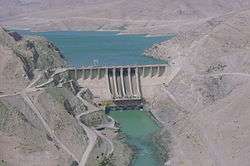Salma Dam
| Salma Dam | |
|---|---|
 Location of Salma Dam in Afghanistan | |
| Official name | Afghan-India Friendship Dam |
| Country | Afghanistan |
| Location | Chishti Sharif District, Herat Province |
| Coordinates | 34°19′51″N 63°49′31″E / 34.33083°N 63.82528°ECoordinates: 34°19′51″N 63°49′31″E / 34.33083°N 63.82528°E |
| Status | Completed |
| Construction began | 1976 |
| Opening date | 4 June 2016 |
| Construction cost | US$ 290 million |
| Operator(s) | WAPCOS |
| Dam and spillways | |
| Type of dam | Embankment, earth and rock-fill |
| Impounds | Hari River |
| Height | 107.5 m (353 ft) |
| Length | 551 m (1,808 ft) |
| Reservoir | |
| Active capacity | 560×106 m3 (453,999 acre·ft) |
| Inactive capacity | 633×106 m3 (513,181 acre·ft) |
| Catchment area | 11,700 km2 (4,500 sq mi) |
| Power station | |
| Turbines | 3 × 14 MW |
| Installed capacity | 42 MW |
| Annual generation | 86.6 GWh |
Salma Dam, officially the Afghan-India Friendship Dam, is a hydroelectric and irrigation dam project located on the Hari River in Chishti Sharif District of Herat Province in western Afghanistan. The Afghan cabinet renamed the Salma Dam to the Afghan-India Friendship Dam in a move to strengthen relations between the two countries.
The hydroelectric plant produces 42 MW of power in addition to providing irrigation for 75,000 hectares of farmland (stabilising the existing irrigation of 35,000 hectares and development of irrigation facilities to an additional 40,000 hectares of land).[1]
The dam was opened on 4 June 2016 by Indian Prime Minister Narendra Modi along with Afghan President Ashraf Ghani.
History
.jpg)
Feasibility reports for the construction of a dam in Chesti-e-Sharif district were prepared in 1957. In 1976, an Afghan firm was tasked with construction of the dam. The firm appointed Water and Power Consultancy Services (India) Ltd (WAPCOS), a company owned by the Indian Ministry of Water Resources, to construct the dam. The 1979 Soviet invasion of Afghanistan halted work on the project.[2][3]
WAPCOS Ltd attempted to continue construction on the dam in 1988, but the project was left incomplete again due to the ongoing instability caused by the civil war. In 2006, India committed to funding the completion of the Salma Dam[4] at an estimated cost of US$ 275 million.[5]
In January 2013, the Indian cabinet approved revised cost of ₹ 1,457 crores (US$ 273.3 million) for the completion of the project and declared it would be completed in December 2014, or two years behind the previous schedule.[6] On 26 July 2015 the dam began to impound its reservoir.
The dam was inaugurated on 4 June 2016 by Indian Prime Minister Narendra Modi along with Afghan President Ashraf Ghani.[7]
Indian Public sector power equipment manufacturer BHEL played an instrumental role in execution of this project by successfully commissioning two 14MW units in Salma Dam (renamed as Afghan-India Friendship Dam) project.[8]
Plots to destroy the dam
Some Afghans believe that politicians in Iran were attempting to stop work on the dam project, which would reduce the flow of river water into Iran.[1] According to the local Afghan National Police of the area, Iranian government is funding local Taliban members to oppose construction of the dam.[1] In 2009, a parliamentarian from Kabul Province, Najibullah Kabuli accused Iran of interfering in the construction of the Salma Dam.
When the governor of Chishti Sharif District, Abdulqudus Qayam, was killed along with five security officials in mid-January 2010, the Afghan media called it an insurgent attack. The Taliban accepted responsibility, but many in Herat saw it as part of a wider problem the province is having with Iran. Qayam had been instrumental in pushing the construction of the dam.[1]
In March 2013, the National Directorate of Security (NDS) claimed that Taliban's Quetta Shura attempted to blow up the Salma Dam with 1,300 kilograms (2,900 lb) of explosives. According to NDS spokesman Shafiqullah Tahiri, "Mullah Abdul Ghani, a member of the Quetta Shura who plans suicide attacks, was behind the conspiracy". The explosives were discovered in a deserted area of the Pashtun Zarghun District of Herat Province, which were smuggled into the area from Balochistan, Pakistan. One person by the name of Sayed Gul was arrested.[9]
See also
References
- 1 2 3 4 "Iran Again Accused of Trying to Halt Afghan Dam". Institute for War & Peace Reporting. Retrieved 6 June 2016.
- ↑ Mitra, Devirupa (4 June 2016). "The Amazing Indian Story Behind Herat's Salma Dam". The Wire. Retrieved 4 June 2016.
- ↑ http://www.afghanembassyjp.com/en/news/947
- ↑ http://www.redorbit.com/news/science/430036/india_to_resume_work_on_salma_dam_in_western_afghanistan/index.html
- ↑ http://www.csmonitor.com/World/Asia-South-Central/2010/0615/Afghanistan-s-woeful-water-management-delights-neighbors
- ↑ "India OKs the Afghan Salma Dam's Revised Cost Estimates". The Gazette of Central Asia. Satrapia. 11 January 2013.
- ↑ "At Afghan dam inauguration, PM promises: India will not forget you". The Indian Express. 4 June 2016. Retrieved 4 June 2016.
- ↑ http://economictimes.indiatimes.com/industry/energy/power/bhel-commissions-two-hydel-units-in-afghanistan/articleshow/52938206.cms
- ↑ "Plot to blow up dam hatched in Quetta: NDS". Pajhwok Afghan News. 1 April 2013. Retrieved 2013-04-01.
